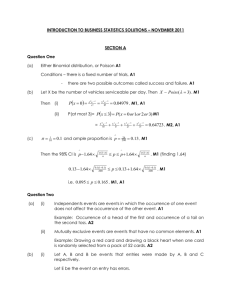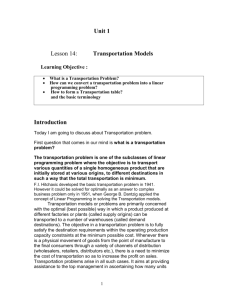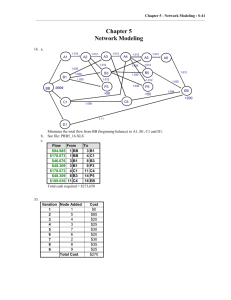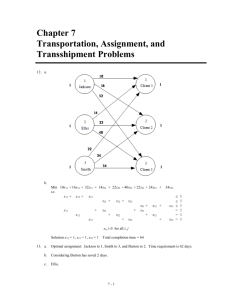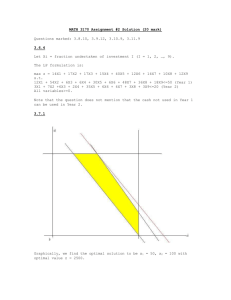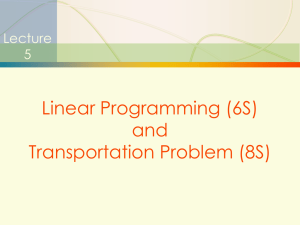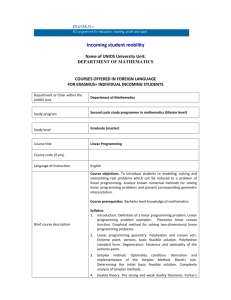PowerPoint
advertisement
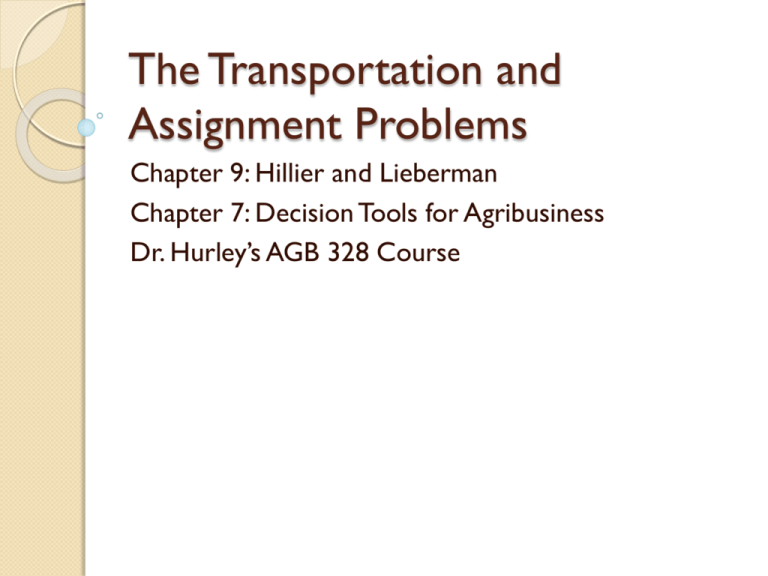
The Transportation and Assignment Problems Chapter 9: Hillier and Lieberman Chapter 7: Decision Tools for Agribusiness Dr. Hurley’s AGB 328 Course Terms to Know Sources, Destinations, Supply, Demand, The Requirements Assumption, The Feasible Solutions Property, The Cost Assumption, Dummy Destination, Dummy Source, Transportation Simplex Method, Northwest Corner Rule,Vogel’s Approximation Method, Russell’s Approximation Method, Recipient Cells, Donor Cells, Assignment Problems, Assignees, Tasks, Hungarian Algorithm Case Study: P&T Company P&T is a small family-owned business that processes and cans vegetables and then distributes them for eventual sale One of its main products that it processes and ships is peas ◦ These peas are processed in: Bellingham, WA; Eugene, OR; and Albert Lea, MN ◦ The peas are shipped to: Sacramento, CA; Salt Lake City, UT; Rapid City, SD; and Albuquerque, NM Case Study: P&T Company Shipping Data Cannery Output Warehouse Allocation Bellingham 75 Truckloads Sacramento 80 Truckloads Eugene 125 Truckloads Salt Lake 65 Truckloads Albert Lea 100 Truckloads Rapid City 70 Truckloads Total 300 Truckloads Albuquerque 85 Truckloads Total 300 Truckloads Case Study: P&T Company Shipping Cost/Truckload Warehouse Cannery Sacramento Salt Lake Rapid City Albuquerque Supply Bellingham $464 $513 $654 $867 75 Eugene $352 $416 $690 $791 125 Albert Lea $995 $682 $388 $685 100 Demand 80 65 70 85 Network Presentation of P&T Co. Problem 464 75 C1 W1 -80 W2 -65 W3 -70 W4 -85 513 867 654 352 416 125 C1 690 791 995 682 388 100 C1 685 Mathematical Model for P&T Transportation Problem 464 x11 513x12 654 x13 867 x14 Minimize 352 x21 416 x22 690 x23 791x24 x11, x12 , x13 , x14 x21, x22 , x23 , x24 995 x 682 x 388 x 685 x 31 32 33 34 x31, x32 , x33 , x34 Mathematical Model for P&T Transportation Problem Cont. Subject to: 𝑥11 + 𝑥12 + 𝑥13 + 𝑥14 = 75 𝑥21 +𝑥22 + 𝑥23 + 𝑥24 = 125 𝑥31 +𝑥32 + 𝑥33 + 𝑥34 = 100 𝑥11 + 𝑥21 𝑥12 +𝑥22 𝑥13 𝑥𝑖𝑗 ≥ 0 + 𝑥31 𝑥14 (𝑖 = 1,2,3; 𝑗 = 1,2,3,4) = 80 + 𝑥32 +𝑥23 +𝑥24 = 65 + 𝑥33 = 70 + 𝑥34 = 85 Transportation Problems Transportation problems are characterized by problems that are trying to distribute commodities from any supply center, known as sources, to any group of receiving centers, known as destinations Two major assumptions are needed in these types of problems: ◦ The Requirements Assumption ◦ The Cost Assumption Transportation Assumptions The Requirement Assumption ◦ Each source has a fixed supply which must be distributed to destinations, while each destination has a fixed demand that must be received from the sources The Cost Assumption ◦ The cost of distributing commodities from the source to the destination is directly proportional to the number of units distributed Feasible Solution Property A transportation problem will have a feasible solution if and only if the sum of the supplies is equal to the sum of the demands. ◦ Hence the constraints in the transportation problem must be fixed requirement constraints met with equality. The General Model of a Transportation Problem Any problem that attempts to minimize the total cost of distributing units of commodities while meeting the requirement assumption and the cost assumption and has information pertaining to sources, destinations, supplies, demands, and unit costs can be formulated into a transportation model Visualizing the Transportation Model When trying to model a transportation model, it is usually useful to draw a network diagram of the problem you are examining ◦ A network diagram shows all the sources, destinations, and unit cost for each source to each destination in a simple visual format like the example on the next slide Network Diagram Demand Supply S1 c11 Source 1 c12 c13 c1n S2 c21 c22 Source 2 c23 c2n S3 Source 3 . . . Sm c31 Source m c32 c33 c3n cm1 cm2 cm3 cmn Destination 1 Destination 2 Destination 3 -D1 -D2 -D3 . . . Destination n -Dn General Mathematical Model of Transportation Problems 𝑛 Minimize Z= 𝑚 𝑖=1 𝑗=1 𝑐𝑖𝑗 𝑥𝑖𝑗 Subject to: 𝑛 𝑗=1 𝑥𝑖𝑗 = 𝑠𝑖 for I =1,2,…,m 𝑚 𝑥𝑖𝑗 = 𝑑𝑗 𝑓𝑜𝑟 𝑗 = 1,2, … , 𝑛 𝑖=1 𝑥𝑖𝑗 ≥ 0, 𝑓𝑜𝑟 𝑎𝑙𝑙 𝑖 𝑎𝑛𝑑 𝑗 Integer Solutions Property If all the supplies and demands have integer values, then the transportation problem with feasible solutions is guaranteed to have an optimal solution with integer values for all its decision variables ◦ This implies that there is no need to add restrictions on the model to force integer solutions Solving a Transportation Problem When Excel solves a transportation problem, it uses the regular simplex method Due to the characteristics of the transportation problem, a faster solution can be found using the transportation simplex method ◦ Unfortunately, the transportation simplex model is not programmed in Solver Modeling Variants of Transportation Problems In many transportation models, you are not going to always see supply equals demand With small problems, this is not an issue because the simplex method can solve the problem relatively efficiently With large transportation problems it may be helpful to transform the model to fit the transportation simplex model Issues That Arise with Transportation Models Some of the issues that may arise are: ◦ The sum of supply exceeds the sums of demand ◦ The sum of the supplies is less than the sum of demands ◦ A destination has both a minimum demand and maximum demand ◦ Certain sources may not be able to distribute commodities to certain destinations ◦ The objective is to maximize profits rather than minimize costs Method for Handling Supply Not Equal to Demand When supply does not equal demand, you can use the idea of a slack variable to handle the excess A slack variable is a variable that can be incorporated into the model to allow inequality constraints to become equality constraints ◦ If supply is greater than demand, then you need a slack variable known as a dummy destination ◦ If demand is greater than supply, then you need a slack variable known as a dummy source Handling Destinations that Cannot Be Delivered To There are two ways to handle the issue when a source cannot supply a particular destination ◦ The first way is to put a constraint that does not allow the value to be anything but zero ◦ The second way of handling this issue is to put an extremely large number into the cost of shipping that will force the value to equal zero Textbook Transportation Models Examined P&T ◦ A typical transportation problem ◦ Could there be another formulation? Northern Airplane ◦ An example when you need to use the Big M Method and utilizing dummy destinations for excess supply to fit into the transportation model Metro Water District ◦ An example when you need to use the Big M Method and utilizing dummy sources for excess demand to fit into the transportation model The Transportation Simplex Method While the normal simplex method can solve transportation type problems, it does not necessarily do it in the most efficient fashion, especially for large problems. The transportation simplex is meant to solve the problems much more quickly. Finding an Initial Solution for the Transportation Simplex Northwest Corner Rule ◦ Let xs,d stand for the amount allocated to supply row s and demand row d ◦ For x1,1 select the minimum of the supply and demand for supply 1 and demand 1 ◦ If any supply is remaining then increment over to xs,d+1, otherwise increment down to xs+1,d For this next variable select the minimum of the leftover supply or leftover demand for the new row and column you are in Continue until all supply and demand has been allocated Finding an Initial Solution for the Transportation Simplex Vogel’s Approximation Method ◦ For each row and column that has not been deleted, calculate the difference between the smallest and second smallest in absolute value terms (ties mean that the difference is zero) ◦ In the row or column that has the highest difference, find the lowest cost variable in it ◦ Set this variable to the minimum of the leftover supply or demand ◦ Delete the supply or demand row/column that was the minimum and go back to the top step Finding an Initial Solution for the Transportation Simplex Russell’s Approximation Method ◦ For each remaining source row i, determine the largest unit cost cij and call it 𝑢𝑖 ◦ For each remaining destination column j, determine the largest unit cost cij and call it 𝑣𝑖 ◦ Calculate ∆𝑖𝑗 = 𝑐𝑖𝑗 − 𝑢𝑖 − 𝑣𝑗 for all xij that have not previously been selected ◦ Select the largest corresponding xij that has the largest negative ∆ij Allocate to this variable as much as feasible based on the current supply and demand that are leftover Algorithm for Transportation Simplex Method Construct initial basic feasible solution Optimality Test ◦ Derive a set of ui and vj by setting the ui corresponding to the row that has the most amount of allocations to zero and solving the leftover set of equations for cij = ui + vj If all cij – ui – vj ≥ 0 for every (i,j) such that xij is nonbasic, then stop. Otherwise do an iteration. Algorithm for Transportation Simplex Method Cont. An Iteration ◦ Determine the entering basic variable by selecting the nonbasic variable having the largest negative value for cij – ui – vj ◦ Determine the leaving basic variable by identifying the chain of swaps required to maintain feasibility ◦ Select the basic variable having the smallest variable from the donor cells ◦ Determine the new basic feasible solution by adding the value of the leaving basic variable to the allocation for each recipient cell. Subtract this value from the allocation of each donor cell Assignment Problems Assignment problems are problems that require tasks to be handed out to assignees in the cheapest method possible The assignment problem is a special case of the transportation problem Characteristics of Assignment Problems The number of assignees and the number of task are the same Each assignee is to be assigned exactly one task Each task is to be assigned by exactly one assignee There is a cost associated with each combination of an assignee performing a task The objective is to determine how all of the assignments should be made to minimize the total cost General Mathematical Model of Assignment Problems Minimize Z= 𝑛𝑖=1 𝑛𝑗=1 𝑐𝑖𝑗 𝑥𝑖𝑗 Subject to: 𝑛 𝑗=1 𝑥𝑖𝑗 = 1 for I =1,2,…,m 𝑛 𝑥𝑖𝑗 = 1 𝑓𝑜𝑟 𝑗 = 1,2, … , 𝑛 𝑖=1 𝑥𝑖𝑗 𝑖𝑠 𝑏𝑖𝑛𝑎𝑟𝑦, 𝑓𝑜𝑟 𝑎𝑙𝑙 𝑖 𝑎𝑛𝑑 𝑗 Modeling Variants of the Assignment Problem Issues that arise: ◦ Certain assignees are unable to perform certain tasks. ◦ There are more task than there are assignees, implying some tasks will not be completed. ◦ There are more assignees than there are tasks, implying some assignees will not be given a task. ◦ Each assignee can be given multiple tasks simultaneously. ◦ Each task can be performed jointly by more than one assignee. Assignment Spreadsheet Models from Textbook Job Shop Company Better Products Company ◦ We will examine these spreadsheets in class and derive mathematical models from the spreadsheets Hungarian Algorithm for Solving Assignment Problems Step 1: Find the minimum from each row and subtract from every number in the corresponding row making a new table Step 2: Find the minimum from each column and subtract from every number in the corresponding column making a new table Step 3: Test to see whether an optimal assignment can be made by examining the minimum number of lines needed to cover all the zeros ◦ If the number of lines corresponds to the number of rows, you have the optimal and you should go to step 6 ◦ If the number of lines does not correspond to the number of rows, go to step 4 Hungarian Algorithm for Solving Assignment Problems Cont. Step 4: Modify the table by using the following: ◦ Subtract the smallest uncovered number from every uncovered number in the table ◦ Add the smallest uncovered number to the numbers of intersected lines ◦ All other numbers stay unchanged Step 5: Repeat steps 3 and four until you have the optimal set Hungarian Algorithm for Solving Assignment Problems Cont. Step 6: Make the assignment to the optimal set one at a time focusing on the zero elements ◦ Start with the rows and columns that have only one zero Once an optimal assignment has been given to a variable, cross that row and column out Continue until all the rows and columns with only one zero have been allocated Next do the columns/rows with two non crossed out zeroes as above Continue until all assignments have been made In Class Activity (Not Graded) Attempt to find an initial solution to the P&T problem using the a) Northwest Corner Rule, b) Vogel’s Approximation Method, and c) Russell’s Approximation Method 8.1-3b, set up the problem as a regular linear programming problem and solve using solver, then set the problem up as a transportation problem and solve using solver In Class Activity (Not Graded) Solve the following problem using the Hungarian method. Case Study: Sellmore Company Cont. The assignees for the task are: ◦ ◦ ◦ ◦ Ann Ian Joan Sean A summary of each assignees productivity and costs are given on the next slide. Case Study: Sellmore Company Cont. Required Time Per Task Employee Word Processing Graphics Packets Registration Wage Ann 35 41 27 40 $14 Ian 47 45 32 51 $12 Joan 39 56 36 43 $13 Sean 32 51 25 46 $15 Assignment of Variables xij ◦ i = 1 for Ann, 2 for Ian, 3 for Joan, 4 for Sean ◦ j = 1 for Processing, 2 for Graphics, 3 for Packets, 4 for Registration Mathematical Model for Sellmore Company 490 x11 574 x12 378 x13 560 x14 Minimize 564 x21 540 x22 384 x23 612 x24 x11 , x12 , x13 , x14 x21 , x22 , x23 , x24 507 x31 728 x32 468 x33 559 x34 x31 , x32 , x33 , x34 480 x31 765 x32 375 x33 690 x34 Mathematical Model for Sellmore Company Cont. Subject to : x11 x12 x13 x14 1 1 x11, x12 , x13 , x14 0 x21 x22 x23 x24 1 1 x21 , x22 , x23 , x24 0 x31 x32 x33 x34 1 1 x31 , x32 , x33 , x34 0 x41 x42 x43 x44 1 1 x31 , x32 , x33 , x34 0 x11 x21 x31 x41 1 x12 x22 x32 x42 1 x13 x23 x33 x43 1 x14 x24 x34 x44 1
